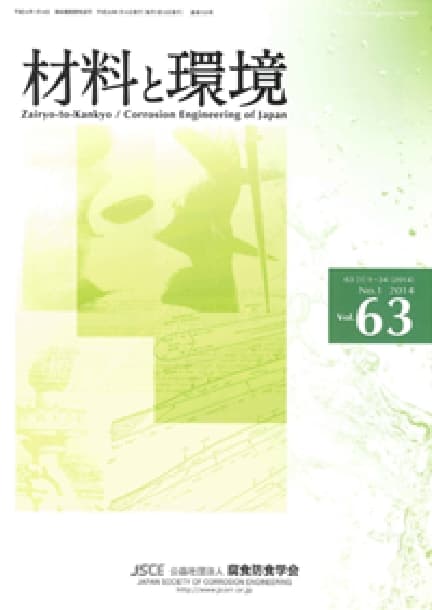- TOP
- Zairyo-to-Kankyo
- Vol. 68 (2019), No. 12
Zairyo-to-Kankyo Vol. 68 (2019), No. 12
Backnumber
-
Vol. 74 (2025)
-
Vol. 73 (2024)
-
Vol. 72 (2023)
-
Vol. 71 (2022)
-
Vol. 70 (2021)
-
Vol. 69 (2020)
-
Vol. 68 (2019)
-
Vol. 67 (2018)
-
Vol. 66 (2017)
-
Vol. 65 (2016)
-
Vol. 64 (2015)
-
Vol. 63 (2014)
-
Vol. 62 (2013)
-
Vol. 61 (2012)
-
Vol. 60 (2011)
-
Vol. 59 (2010)
-
Vol. 58 (2009)
-
Vol. 57 (2008)
-
Vol. 56 (2007)
-
Vol. 55 (2006)
-
Vol. 54 (2005)
-
Vol. 53 (2004)
-
Vol. 52 (2003)
-
Vol. 51 (2002)
-
Vol. 50 (2001)
-
Vol. 49 (2000)
-
Vol. 48 (1999)
-
Vol. 47 (1998)
-
Vol. 46 (1997)
-
Vol. 45 (1996)
-
Vol. 44 (1995)
-
Vol. 43 (1994)
-
Vol. 42 (1993)
-
Vol. 41 (1992)
-
Vol. 40 (1991)
Keyword Ranking
18 Dec. (Last 30 Days)
Zairyo-to-Kankyo Vol. 68 (2019), No. 12
Evaluation of Relationship between Corrosion Thickness Reduction and Propagation Mode of AE Wave
Takuya Kurihara, Takuma Kagami, Matsuo Takuma, Taro Kono, Naoto Nakasato
pp. 342-346
DOI:
10.3323/jcorr.68.342Abstract
Corrosion loss evaluation method for steel structure was investigated by acoustic emission (AE) signals with characteristics of Lamb wave. Relationship between wavelet coefficient of S0 mode of Lamb wave AE signals and AE source depth were evaluated. The amplitude of the S0 mode becomes higher as the AE source become closer to the thickness center. Thus, the corrosion depth can be evaluated by the strength ratio of S0 mode and A0 mode of Lamb wave AE signals.
Observation of Pit Initiation and Growth of Stainless Steel under a Chloride Solution Droplet―Effect of S Content on Pit Initiation, Growth and Repassivation―
Azusa Ooi, Yaoki Ise, Eiji Tada, Atsushi Nishikata
pp. 347-354
DOI:
10.3323/jcorr.68.347Abstract
A system that can stop pit growth automatically at any time after the pit initiation under a chloride solution droplet was developed. Using this system, atmospheric pitting corrosion of austenitic stainless steels with various sulfur (S) concentrations was investigated. It was confirmed that initiation site of pitting corrosion was manganese sulfide (MnS) inclusions under the droplets regardless of S concentrations. In addition, the growth behavior of the active dissolution area doesn't also depend on S concentrations. When these specimens were subjected to wet-dry cycle tests, probability of pitting corrosion increases with S concentrations due to increasing initiation site, and there is no clear difference in chloride concentrations for onset of the pitting corrosion. On the other hand, repassivation behavior is strongly depends on S concentrations.
Article Access Ranking
18 Dec. (Last 30 Days)
-
Delayed Fracture Mechanism of 1700 MPa-Class Quenched and Tempered Bolt under Atmospheric Corrosion Environment
Tetsu-to-Hagané Advance Publication
-
Perspectives on the Promising Pathways to Zero Carbon Emissions in the Steel Industry toward 2050
ISIJ International Vol.65(2025), No.2
-
Effect of B on Surface Oxidation Behavior and Phosphatability of Si-Mn-added Cold-Rolled Steel Sheets
ISIJ International Advance Publication
-
Factors Influencing the Bonding Phase Structure of Iron Ore Sinters
ISIJ International Vol.43(2003), No.9
-
Effect of microstructural heterogeneity on fatigue limit of as-quenched low-carbon low-alloy martensitic steel
ISIJ International Advance Publication
-
Prussian blue as a fully reversible hydrogenochromic material for visualizing hydrogen distribution in Fe sheet
ISIJ International Advance Publication
-
Metallurgical Aspects on Interstitial Free Sheet Steel From Industrial Viewpoints
ISIJ International Vol.34(1994), No.1
-
Microstructures and Reduction Properties of High CaO Concentration Sintered Ore
ISIJ International Advance Publication
-
Influence of Antimony on the Oxidation Characteristics of 65Mn Steel
ISIJ International Advance Publication
-
From plasticity to fracture in pearlitic microstructures: Atomistic study of cementite thickness and deformation localization
ISIJ International Advance Publication
You can use this feature after you logged into the site.
Please click the button below.










